After a leisurely breakfast, we headed up to the very north of the island, passing through torrential downpours. It was indeed very remote up there, with small isolated villages scattered across vast tracts of agricultural land. But this remoteness added to its strange charm.
We turned off to North Point, carefully bypassing the conch seller who pleaded for us to stop and listen to his spiel. A motley collection of cars and coaches lined up on the marl car park of this remote promontory. Souvenir shops, a cafe and bar provided the necessary anchor to the tourist world.
A small path along the top of the cliffs provided the opportunity to gulp in lungfuls of tangy, salt air. Below us mighty rolling waves exploded on the cliffs, and collapsed into a maelstrom of boiling foam, a scene not too dissimilar from Lonely Bay. I always find such tumultuous waters mesmerising.
A few benches were strung out along the path, and I fell into conversation with an elderly couple on one of these. The lady was Irish, and related her story. "I live for part of the year on Barbados. The rest of the year is spent in New York and back home in Ireland. I once worked as a nurse in New York for a member of the Guinness family. This family member was an amputee, and thus needed a lot of medical care around him. One day, he announced, 'OK, we are all going to Barbados for a while.' So all the family and attendant nurses were whisked off to Barbados. I totally fell in love with this lovely island, and eventually bought a condo in Holetown. I now return here every year."
The chap who sat next to her, who I took to be her friend, was an elderly chap from Stockport. His cousin's son bought a condo in the same block as the lady. He had been coming out to Barbados every year for the past 13 years, ".... to escape the hard winters," he explained.
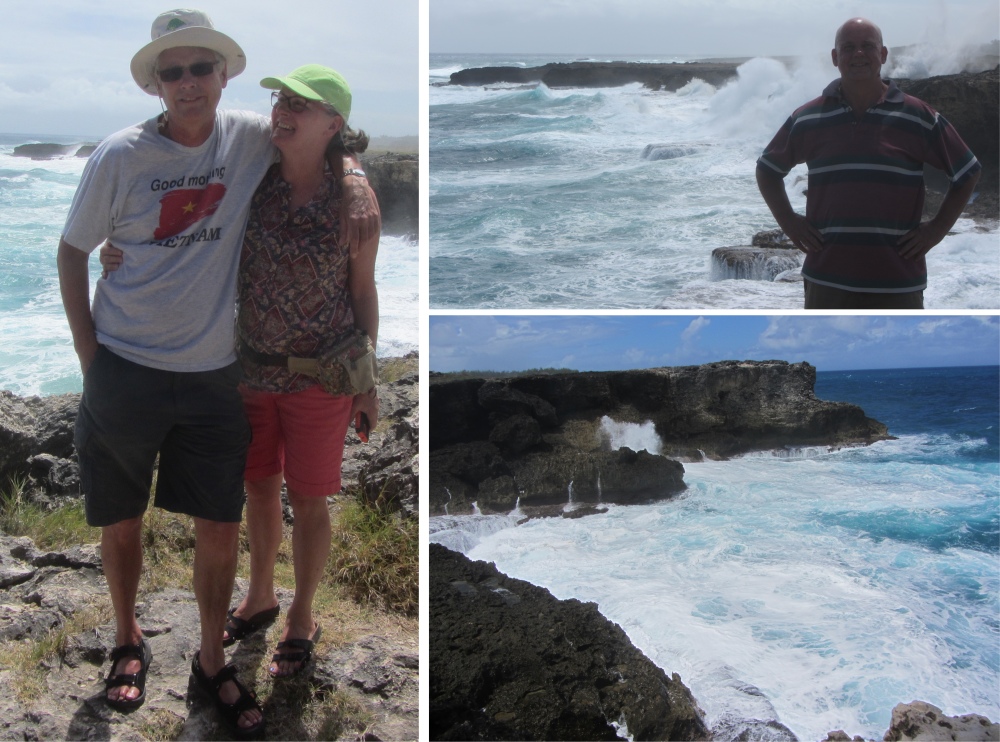
Tumultuous Seas and Three Penguins at North Point
|
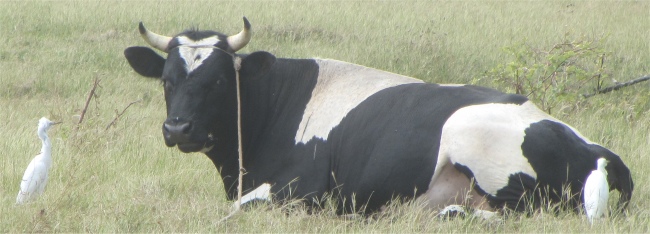
Cattle Egret and Friend
|
We left the couple who were also enchanted by the environment at this northern extreme, and headed toward the coastal road that traced the western seaboard of the island. Traversing a large swathe of pasture land, I spotted a Cattle Egret. Once a seasonal visitor to the shores of Barbados since the 1970s, the Cattle Egret has now become a permanent breeding resident on our island. A white bird with a short sturdy yellow bill and a humped looking posture, Cattle Egrets are renowned for rummaging through freshly cultivated soil or riding along the backs of cattle. It was once thought that while on the backs of cattle, they were there primarily for the purpose of removing ticks. However, their ride on the backs of cattle is in an effort to successfully capture pests that are attracted to cattle. Working in harmony, the male collects the necessary materials for nest construction while the female takes pride in building the nest. Nests are quite simple looking in appearance as they form a relatively untidy and small platform in trees. Hmmm... I suppose women are always the best at being home builders.
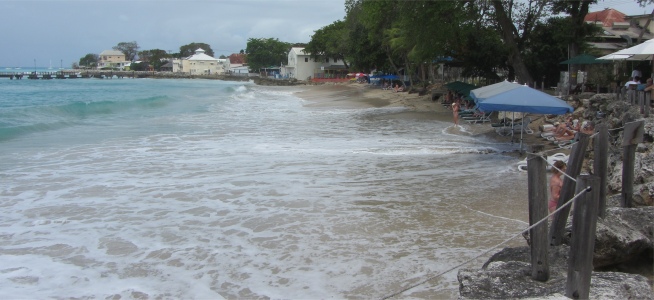
Speightstown Beach
|
Near the western coast Meryl caught sight of Harrison's Point Light House; perhaps worthy of a visit we thought. We made our way down warrens of back lanes, all of which petered out into dead-ends, and gave up in frustration. The tall chimney of the Arawak Cement Company Ltd. served as a useful landmark from which we could navigate along unmarked roads across to the coastal road.
As we approached Speightstown, we started to encounter many elegant private houses and hotels along the coast. Once parked up, we found a small cafe that overlooked the beach and enjoyed a refreshing drink of freshly made lemonade. An impressive, large mural depicting "The Bridge of Tides" adorned a wall behind us. Large waves were crashing onto the shore before us and surging up the beach. It did not look particularly inviting to swimmers, and those who attempted to enter the waves were soon swept off their feet and deposited as wet rags among the weed at the top of the beach. Dads building sand-castles for their youngsters watched in dismay as their efforts were washed away by rogue waves that swept over their fortifications. The youngsters yelped with glee and uttered a chorus of, "Again daddy!"
Speightstown, on the north-western side of the island, is classified as the second largest town on the island. The town was settled in 1630, and named after William Speight, a member of Barbados' first Assembly during the colonial years as well as the former land owner where the town is located. The island's first map, drawn by Captain John Swan around 1640, showed the area known as Spykeses Bay, but it was pronounced Spykestown ever since by many Bajans. In its heyday, back in the 17th century, Speightstown was considered a thriving port and was an important link in the island's trading activities. Ships laden with sugar and other commodities left Speightstown bound directly for London, and especially Bristol. For this reason Speightstown is sometimes known as Little Bristol.
The Bajans at this time were loyal to Charles I, and rejected Oliver Cromwell as their protector. Cromwell, in his usual style, sent George Ayscue across to Barbados to quell the insurrection in 1649. Concentrated attacks by Ayscue, over a six month period on Speightstown, were repelled by the small forts along the shore, and he never succeeded in capturing the town. The only way Ayscue succeeded in subduing the island was with the help of a defector, who led him and his men to land at Oistins Town, where they met with representatives of the island, and in 1652 signed what has become known as the "Charter of Barbados". The agreement gave Barbados rights and privileges unheard of in any other Island. In particular it guaranteed that Barbados could not be taxed without the consent of a Barbados General Assembly.
We strolled along the pavement along the main drag, Church Street, where street vendors proudly displayed their wares: fresh seasonings, fresh fruits and vegetables, fish, and drinks. Behind them stood a collection of retail stores of every kind: boutiques, hardware, plumbing and haberdashery to name a few.
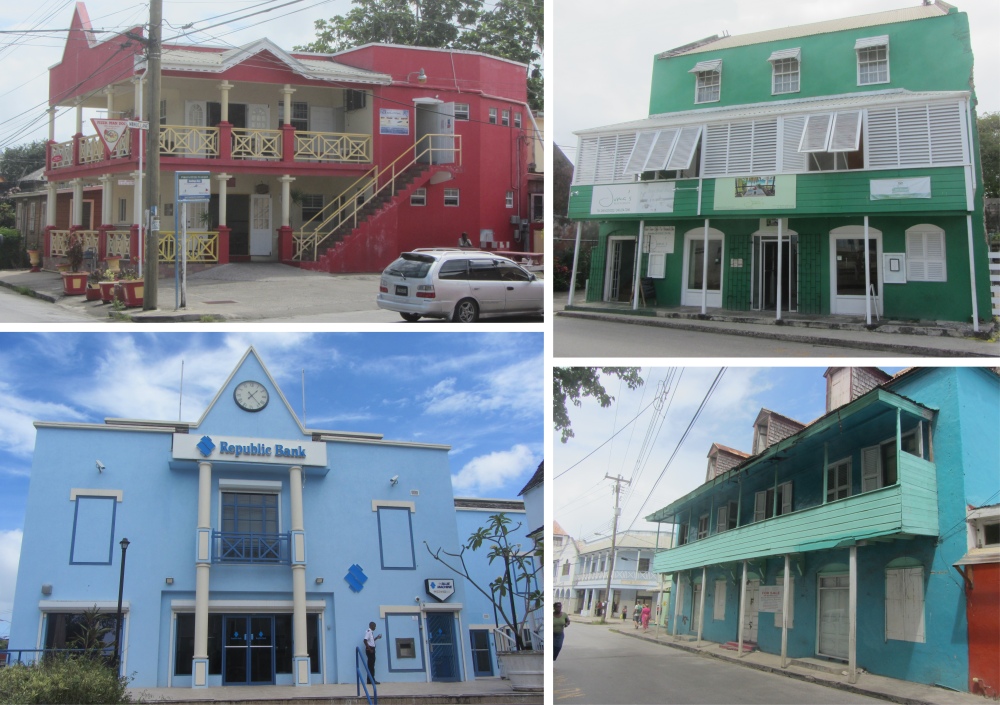
Speightstown Colonial Architectures
|
Much of the character of Speightstown can be found in its architecture. Historic buildings dating back to colonial times sit cheek by jowl alongside modern buildings, reflecting a developing nation, and in its people. Many were brightly coloured and featured the trademark overhanging galleries, as well as premium views of the calm, serene Caribbean Sea which literally forms their backyards. Once one of Barbados's busiest ports, Speightstown has undergone a renaissance of sorts and is once again an active and vibrant town while still maintaining a colonial charm.
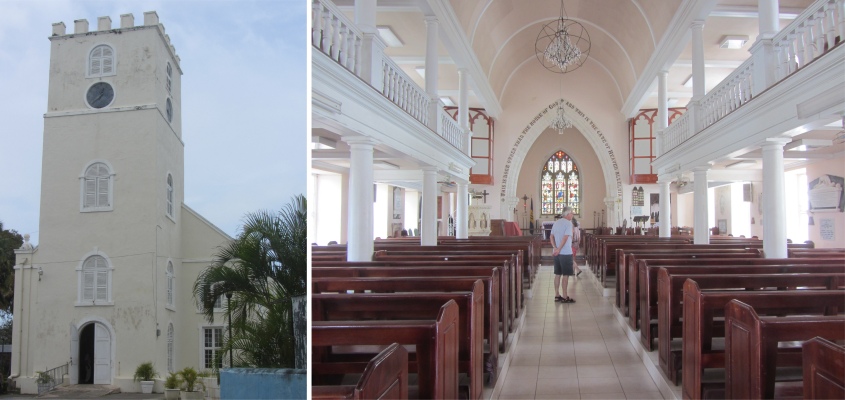
St. Peter's Parish Church
|
In the centre of town sits St. Peter's Parish Church. The church dates as far back as 1629, when a wooden structure served as the parish church for the area. The second church was built 36 years later and a third church followed in 1837 after the 1831 hurricane. This third church survived well into the 20th century but then on 21st April 1980 tragedy struck and the church was largely destroyed by fire. The church building sustained damage primarily to the interior with the exterior walls and the tower escaping much of the damage. The church was subsequently restored to its former glory with one marked exception. The large bell that was previously housed in the church's clock tower could not be returned to its former location and so the bell is now housed on the outside of the church building, under a gazebo-like structure, as a constant reminder of life's affinity for change.
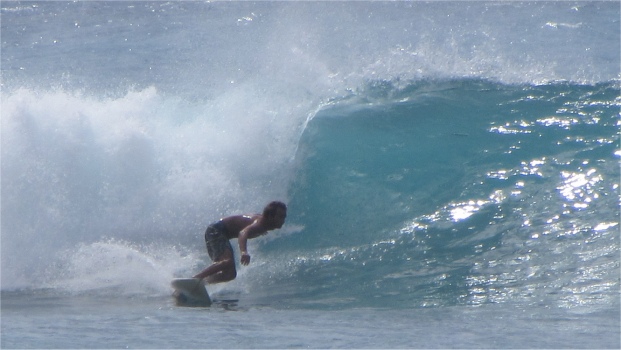
Surfer at Reeds Bay
|
The first thing that caught my eye when I entered the church was the inscription carved in stone positioned directly above the altar,
"This is none other than the House of God and this is the Gate of Heaven Alleluia". Some other examples can be found in the ornately carved pulpit inscribed with the words
"Given to the Glory of God by Little John in memory of his mother", while the baptismal font at the back of the church bears the inscription
"The Geft of John Sober Esq. to the Parish of Saint Peter 1767".
We left this historic town and carried on down the coast, stopping off at Reeds Bay. Here we tarried for a while to watch surfers slowly fight their way out to deeper water, where they hung around until a suitable wave tempted them to ride it. The rollers were quite hefty, and occasionally the surfers would be totally wiped out.
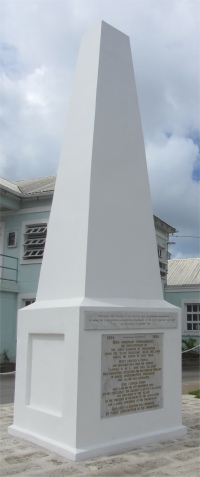
Memorial Commemorating
the First Landing
|
A short distance further down the coast lay Holetown. Captain John Powell was blown off-course from South America to England, and took the opportunity to claim the island for the Kingdom of England. He and a band of sailors stepped ashore here in 1625, and named the town Jamestown, after James I. On 17th February 1627, the brother of Captain John Powell, Captain Henry Powell, aboard the
"Olive Blossom" returned with his benefactor, Sir William Courteen, a Dutch-born English merchant trader, and fifty other shareholder settlers (and 10 captive Negroes). An obelisk monument on the main road has been erected to commemorate this first landing on the island, erroneously recording the date as 1605.
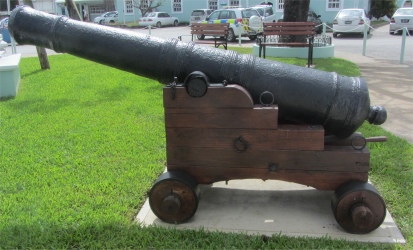
Holetown Canon
|
By this time James I had passed away, and the settlers renamed the town Holetown. The inlet where they were anchored reminded them of a stretch of the Thames called Limehouse Hole. Holetown celebrates the founding of the first five plantations in Barbados, the first major fortification, the first place of Justice, and the first Governor's House. The town was also involved in the transatlantic trade with Bristol, London, and Boston, although Boston was deemed illegal. After Lord Carlisle gained control of Barbados as a protectorate of The Crown, he decided to found his own settlement in the southern part of the island. Carlisle's move gave way to Bridgetown being settled along Carlisle Bay and a shift of the capital for the island to that location.
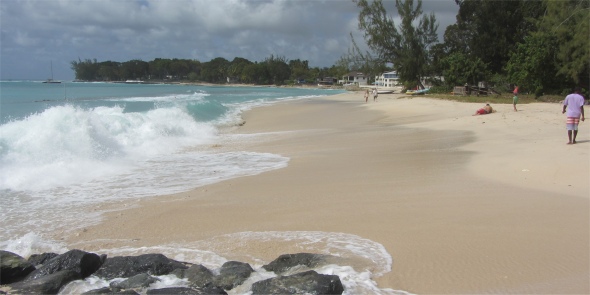
Holetown Beach
|
Holetown was a collection of bars and restaurants, with token displays and relics to indicate the town's past, nothing to write home about. The beach was quite small, and a red flag warned folk it was not safe to swim today. Similar to Speightstown, waves endlessly crashed and surged up the shore. Again little boys encouraged dads to build sand castles, which were duly plundered by the advancing waves, and mams tried to console the little fellows. A smattering of bars faced the shore, where newly arrived tourists chilled as their throbbing burnt bodies slowly turned up the pain levels. We joined a few folk on a short concrete groin to shoot the breeze for a while.
Our explore complete, we headed back to base. Rex and I were eager to cook tonight. From the amount of garlic we included, we would be guaranteed a 20m exclusion zone the following day. Not to worry, garlic is meant to be good for you.









